TechRadar Verdict
Pros
- +
Fabulous CinemaScope treatment of Blu-ray
- +
Manageable size for living room
- +
Affordable 3D glasses
- +
Built-in speakers
- +
Detailed images
Cons
- -
21:9 zoom can go awry on 16:9 footage
- -
Net TV underwhelms
- -
Lacks ultimate contrast
- -
Ambilight too separated
- -
Picture can look processed
Why you can trust TechRadar
This LED TV may have unusual, almost unique, dimensions that lend it an almost futuristic appearance.
But the ultra-widescreen Philips 50PFL7956T Cinema 21:9 Gold's strange shape will make a lot of sense to committed movie buffs.
The reason for its existence, of course, is CinemaScope. Films have been shot in the super-wide 2.39:1 format for yonks, and even now most films are presented on DVD or Blu-ray with black bars above and below them.
The flipside with this TV is that anything not filmed in CinemaScope – such as broadcast TV programmes – theoretically need black bars on each side. The Philips 50PFL7956T promises to upsize regular widescreen fare to fit well on the super-wide Edge LED panel, which it does primarily by zooming in slightly.
Given its widescreen shape, the Philips 50PFL7956T is a TV strictly for movies, although its smaller size indicates that it's aimed just as much at living rooms as at dedicated home cinema rooms.
It's dressed to impress, too, with an ever-so-slightly gold-tinged metallic silver casing that's more than skin deep. This is one of the most solid and attractive TVs we've yet seen, and eons ahead of its gloss black plastic rivals.
How it differs to the previous incarnation, the Philips 58PFL9955H, is two-fold. As well as not being nearly as expensive, the Philips 50PFL7956T – a full eight inches smaller in the diagonal, but only 32mm in depth – has a much smaller footprint. It's very difficult to compare Cinema 21:9 sets with 'normal' TVs because of the way they're measured, but for the sake of argument it's best to think of the Philips 50PFL7956T as a stretched 42-inch TV – the footprint is roughly similar.
Sign up for breaking news, reviews, opinion, top tech deals, and more.
This is actually Philips' smallest version of its now two-strong Cinema 21:9 range, with the flagship 58-inch Philips 58PFL9956 Cinema 21:9 Platinum also available.
Aside from width, the major difference between the two ultra-widescreen TVs is their flavour of 3D. The Philips 50PFL7956T sports the cheap passive 3D system, which Philips calls Easy 3D, while the 58PFL9956 pushes its flagship credentials by using the pricier, more detailed active shutter 3D system, termed 3D Max in the Philips lexicon.
This dual approach to 3D is an odd one, but seems to have been adopted to ensure that some of Phillips' mid-range standout TVs remain affordable. Relatively speaking, that's the case here - despite its high price, this is an attempt to get 21:9 ratio televisions into the mainstream.

Elsewhere in Philips' rather late arriving arsenal are some good value, more normally proportioned offerings. The entry-level 7000 Series consists of the 37-inch Philips 37PFL7666, 42-inch Philips 42PFL7666 and the 47-inch Philips 47PFL7666.
Next up is the 8000 Series, with the 40-inch Philips 40PFL8606, 46-inch Philips 46PFL8605 and the 52-inch Philips 52PFL8605 that all swap Easy 3D for 3D Max.
Finally there's the no-holds-barred 9000 Series, whose star turn is undoubtedly the 46-inch Philips 46PFL9706, which uniquely comes complete with a Moth Eye Filter – a reflection-eliminating nanostructure, if you're asking. The 9000 Series also includes the 52-inch Philips 52PFL9706, although this one doesn't have Moth Eye.

Jamie is a freelance tech, travel and space journalist based in the UK. He’s been writing regularly for Techradar since it was launched in 2008 and also writes regularly for Forbes, The Telegraph, the South China Morning Post, Sky & Telescope and the Sky At Night magazine as well as other Future titles T3, Digital Camera World, All About Space and Space.com. He also edits two of his own websites, TravGear.com and WhenIsTheNextEclipse.com that reflect his obsession with travel gear and solar eclipse travel. He is the author of A Stargazing Program For Beginners (Springer, 2015),
